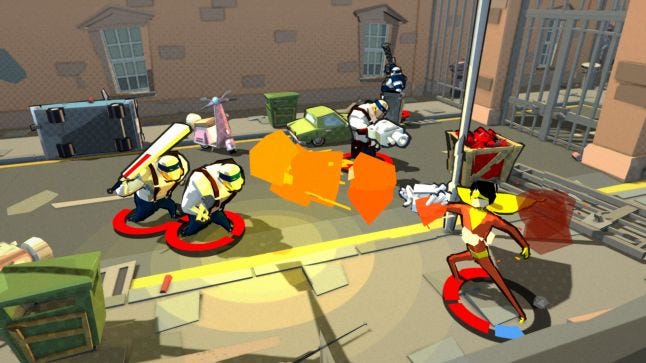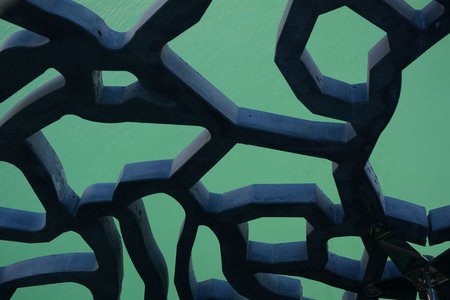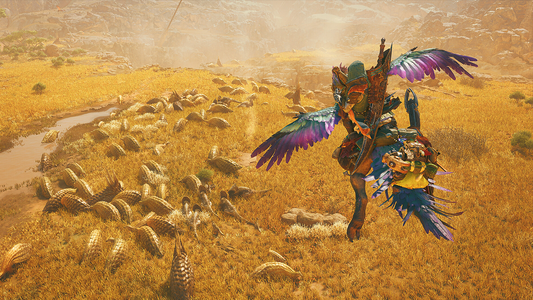The key to any good brawler is a robust combo system. This was the challenge that presented itself to the team at Upstream Arcade when they decided to try their hand at the beat 'em up genre with Deadbeat Heroes.
You take control of a group of low-powered heroes whose only superpower is that they can steal abilities from the enemies they defeat. In each stage, you'll wall-run and dodge your way around the arena, punching and blasting villains, while powering up special attacks and saving the civilians caught in the crossfire.
The team had to overcome several problems during development to accomplish a fun and varied combat system. This included how to make combos feel intuitive, how to incentivize the player to use them, and how to keep the combat fresh throughout.
They did this by enhancing the onscreen readability, offering players better scores for chaining moves, and introducing new attacks to unlock as time goes on.
The origin story
"Imkan and I used to play a lot of brawlers during our lunchtimes at Lionhead. We really love couch co-op games. It was something that we were itching to do ourselves."
Developers Imkan Hayati and Adam Langridge started Upstream Arcade with the goal of creating something unlike what they'd done during their time at the now-defunct Lionhead Studios, where they worked on the combat system of Fable II, among other things. Inspired by their mutual love of superheroes, and classic brawlers like Power Stone, they came up with the concept of a beat 'em up centred around a group of British heroes.
"Imkan and I used to play a lot of brawlers during our lunchtimes at Lionhead. They're one of our favourite kinds of games to play," Langridge says. "We really love couch co-op games. So that was a genre we felt hadn't had an awful lot of attention and it was something that we were itching to do ourselves and turn our hats to."
He adds, "What we also wanted to do was look at movement based gameplay, as opposed to the kind of games where the intricacies are under the hood. When I talk about movement based gameplay what I mean is there's no block button. If you want to not get hurt, you've got to not get hit. So we really liked the idea of dodging, running along walls, and evading. Dodging bullets first, then attacking."

Building in predictability
"We put a lot of energy into making the ricochet and movement system robust and predictable. If you hit a baddie in a direction, they'll fly a fair distance, and if they hit a wall, they'll fly back a fair distance."
The movement-based gameplay they were aiming for demanded close attention to ensure it was predictable and that players could chain combos efficiently. One of the ways they did this was by adding secret, little aids for the player, like a hidden targeting system if you're near an enemy and a collision system that's less chaotic.
"We put a lot of energy into making the ricochet system and movement system quite robust and predictable," says Langridge. "So, you know if you hit a baddie in a direction, they'll fly a fair distance, and if they hit a wall they'll fly back quite a fair distance. Mechanically, I was quite careful to try and not run it purely as how a physics simulation would do it, but game-ify it up. Baddies bounce back from the wall, straight back from the wall, no matter what angle they go in. That helps the player."
These features make it so that no matter the stage or the obstacles you're faced with, such as moving platforms, jagged terrain, or rotating blades, you're able to predict how an enemy will respond to being pushed against it.

Improving the visibility
"We did a lot of tuning in terms of prioritizing the scene visually. We went through quite a few iterations of how to push back the background."
How the team handled visibility is also an extension of this. The game can get quite chaotic, so they needed to take steps to guarantee the player is always aware of their surroundings and able to chain attacks effectively.
"We ended up doing a lot of tuning about visibility in terms of prioritizing the scene visually," says Langridge. He continues, "We went through quite a few iterations of how to push back the background in the scene. We did stuff like desaturating the palette and we simplified the rendering of it. Equally, anything that's dangerous or alive we up the importance of. We do that with color, with outlining, and then also with the heroes themselves. We made them the brightest things usually that are around."
All of these techniques combine to let the player keep track of the action onscreen, so they are capable of planning ahead or identifying obstacles that may break their chains. They also introduced additional environmental effects, like motion smearing and ghost trails to accomplish this further.

Adding an incentive
No tags.






































